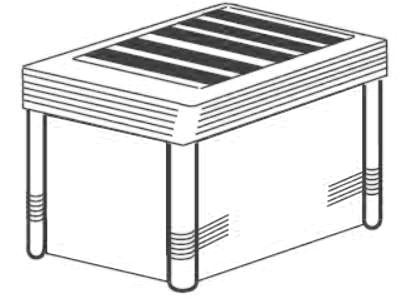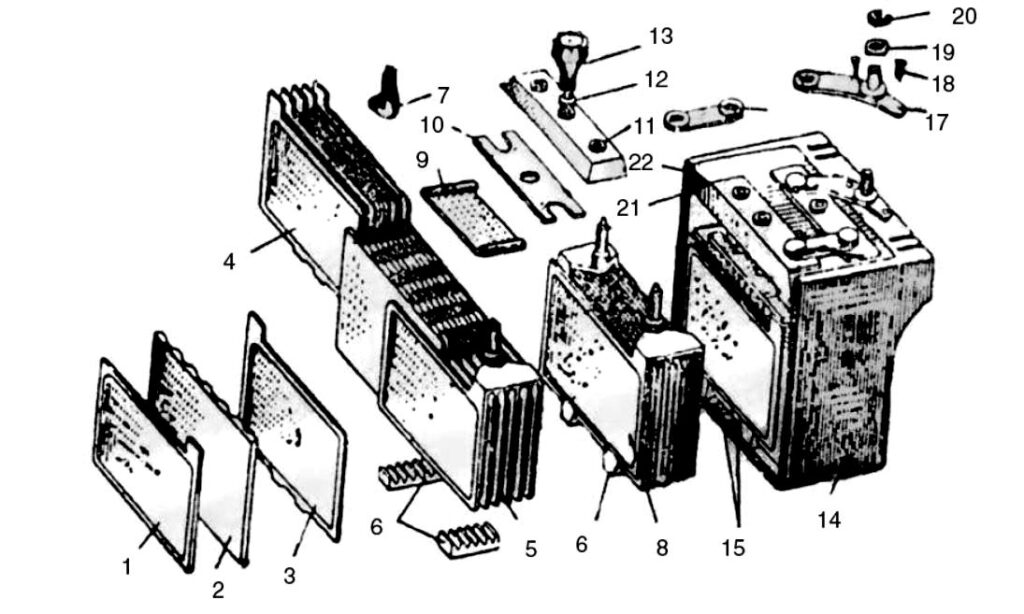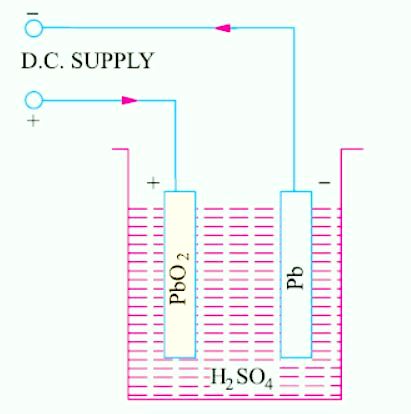Lead Acid Battery Construction and Working Principle
What is Lead Acid Battery?
Definition: The battery which uses sponge lead and lead peroxide for the conversion of the chemical energy into electrical power, such type of battery is called a lead acid battery. The lead acid battery is most commonly used in the power stations and substations because it has higher cell voltage and lower cost.
Lead Acid Battery Construction
A battery consists of a number of cells and each cell of the battery-consists of (a) positive and negative plants (b) separators and (c) electrolyte, all contained in one of the many compartments of the battery container.
Different parts of a lead-acid battery are as under :
(i) Plates. A plate consists of a lattice type of grid of cast antimonial lead alloy which is covered with active material. The grid not only serves as a support for the fragile active material but also conducts electric current. Grid for the positive and negative plates are often of the same design although negative plate grids are made somewhat lighter. Positive plates are usually Plante plates whereas negative plates are generally of Faure or pasted type.
(ii) Separators. These are thin sheets of a porous material placed between the positive and negative plates for preventing contact between them and thus avoiding internal short-circuiting of the battery. A separator must, however, be sufficiently porous to allow diffusion or circulation of electrolyte between the plates. These are made of especially-treated cedar wood, glass wool mat, microporous rubber (mipor), microporous plastics (plastipore, miplast) and perforated p.v.c. as shown in Figure given below.

AdBlock-2
In addition to good porosity, a separator must possess high electrical resistance and mechanical strength.
(iii) Electrolyte. It is dilute sulphuric acid which fills the cell compartment to immerse the plates completely.
(iv) Container. It may be made of vulcanised rubber or moulded hard rubber (ebonite), moulded plastic, ceramics, glass or celluloid. The vulcanised rubber containers are used for car service, while glass containers are superior for lighting plants and wireless sets. Celluloid containers are mostly used for portbable wireless set batteries. A single mono block type container with 6 compartments generally used for starting batteries is shown in Figure given below.

Full details of a Russian 12-CAM-28 lead-acid battery parts are shown in Figure given below. Details of some of these parts are as follows:
(a) Bottom Grooved Support Blocks. These are raised ribs, either fitted in the bottom of the container or made with the container itself. Their function is to
1. − ve plate
2. separator
3. + ve plate.
4. + ve group
5. − ve group
6. − ve group grooved support block
7. lug
8. plate group
9. guard screen
10. guard plate
11. cell cover
12. plug washer
13. vent plug
14. monoblock jar
15. supporting prisms of + ve group
16. inter-cell connector
17. terminal lug
18. screw
19. washer
20. nut
21. rubber packing
22. sealing compound.

Active materials of a Lead-acid Cell
Those substances of the cell which take active part in chemical combination and hence absorb or porduce electricity during charging or discharging, are known as active materials of the cell.
The active materials of a lead-acid cell are :
1. Lead peroxide (PbO2) for + ve plate
2. Sponge Lead (Pb) for − ve plate
3. Dilute Sulphuric Acid (H2SO4) as electrolyte.
1. Lead Peroxide
It is a combination of lead and oxygen, is dark chocolate brown in colour and is quite hard but brittle substance. It is made up of one atom of lead (Pb) and two atoms of oxygen (O2) and its chemical formula is PbO2. As said earlier, it forms the positive active material.
2. Sponge Lead
It is pure lead in soft sponge or porous condition. Its chemical formula is Pb and forms the negative active material.
3. Dilute Sulphuric Acid
It is approximately 3 parts water and one part sulphuric acid. The chemical formula of the acid is H2SO4. The positive and negative plates are immersed in this solution which is known as electrolyte. It is this medium through which the current produces chemical changes. Hence, the lead-acid cell depends for its action on the presence of two plates covered with PbO2 and Pb in a solution of dilute H2SO4 of specific gravity 1.21 or near about. Lead in the form of PbO2 or sponge Pb has very little mechanical strength, hence it is supported by plates of pure lead. Those plates covered with or otherwise supporting PbO2 are known as + ve plates and those supporting sponge lead are called −ve plates. The + ve and −ve plates are arranged alternately and are connected to two common +ve and −ve terminals.
Working Principle
(i) DISCHARGING
When the cell is fully charge, its positive plate or anode is PbO2 (dark chocolate brown) and the negative plate or cathode is Pb (slate grey). When the cell discharges i.e. it sends current through the external load, then H2SO4 is dissociated into positive H2 and negative SO4 ions. As the current within the cell is flowing from cathode to anode, H2 ions move to anode and SO4 ions move to the cathode.
At anode (PbO2), H2 combines with the oxygen of PbO2 and H2SO4 attacks lead to form PbSO4.
PbO2 + H2 + H2SO4 ⎯→ PbSO4 + 2H2O
At the cathode (Pb), SO4 combines with it to form PbSO4
Pb + SO4 ⎯→ PbSO4
It will be noted that during discharging :
(i) Both anode and cathode become PbSO4 which is somewhat whitish in colour.
(ii) Due to formation of water, specific gravity of the acid decreases.
(iii) Voltage of the cell decreases.
(iv) The cell gives out energy.

(ii) CHARGING
When the cell is recharged, the H2 ions move to cathode and SO4 ions go to anode and the following changes take place :
At Cathode PbSO4 + H2 ⎯⎯→ Pb + H2SO4
At Anode PbSO4 + 2H2O ⎯⎯→ PbO2 + 2H2SO4
Hence, the anode and cathode again become PbO2 and Pb respectively.
(i) The anode becomes dark chocolate brown in colour (PbO2) and cathode becomes grey metallic lead (Pb).
(ii) Due to consumption of water, specific gravity of H2SO4 is increased.
(iii) There is arise in voltage.
(iv) Energy is absorbed by the cell.
The charging and discharging of the cell can be represented by a single reversible equation given below :


For discharge, the equation should be read from left to right and for charge from right to left
Read article – Primary and secondary Battery
Visit NCERTplanet.com for NCERT solutions and Textbook downloads




